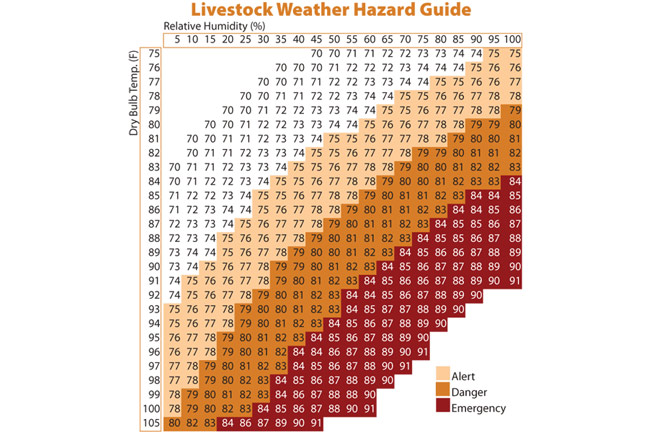
Agricultural News
Dave Sparks Asks, 'How Hot is Too Hot?' for Livestock
Tue, 25 Jun 2013 17:24:32 CDT

Dave Sparks DVM, Oklahoma State University Area Extension Veterinarian, writes in the latest Cow-Calf Newsletter:
All good stockmen are aware that heat stress can be a problem in livestock as the summer heats up, but not all are aware that other factors can enter the equation besides the thermometer reading. These same factors can be dangerous to the people that handle the livestock as well, but we can do things that help to compensate for the danger. When our bodies cannot dissipate heat adequately to maintain a normal body temperature we retreat to the air conditioner, drink more water, or go to the shade. These options may not be available to our livestock.One factor that affects the danger level for heat stress greatly is humidity. As shown in the accompanying table, temperature levels that may not pose a threat at lower humidity levels can become dangerous as humidity rises. Livestock can enter the critical zone at 90 °F if the relative humidity is high enough. We can't do much to change the humidity, but we can avoid other problems that may have an additive effect.
Lack of shade can also make a big difference in heat stress. As ruminants, it is normal for cattle to ingest large quantities of forage and then rest and digest. The heat of fermentation produced in the rumen must be eliminated and a shady place to rest is important. As an experiment, place a thermometer in a shady place and another nearby but just outside the shade on a hot day and note the dramatic difference. Remember that any time the ambient temperature exceeds body temperature the cattle cannot dissipate heat and their body temperature rises.
An adequate supply of clean drinking water helps maintain a safe body temperature. When cattle are allowed to stand, defecate, and urinate in water sources the palatability of the water can decline until the animals choose to limit their intake. Research has shown that when animals are fenced out and vegetation is allowed to grow to the water's edge, the water stays cooler as well as cleaner.
The endotoxins associated with tall fescue can cause a rise in body temperature of several degrees. This can make the difference between safe and critical conditions when other factors are marginal. Cattle on fescue pastures can often be seen to seek refuge in ponds or shade when cattle grazing adjoining non-fescue pastures are still actively grazing.
Perhaps the greatest heat stress danger, for man and beast, is activity level. Weaning calves that are walking and bawling are at much greater risk. When environmental factors approach the danger zone avoid working and processing animals if possible. If that is not possible plan activity for early in the morning before the day's heat buildup begins and after the previous day's heat buildup is dissipated. Do not process cattle in the evening. Even though air temperatures may go down it takes several hours for body temperatures to return to normal after the day's heat accumulation in the tissues.
Every summer cattle are lost to heat stress. A little planning and common sense can go a long way towards minimizing these losses. A good rule of thumb is if it is too hot for you, it is too hot for your livestock.
WebReadyTM Powered by WireReady® NSI
Top Agricultural News
More Headlines...


















